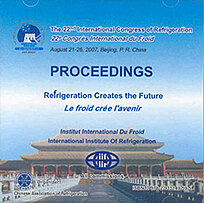
IIR document
Experimental study on falling-film heat transfer enhancement of binary nanofluids.
Author(s) : LEE K. I., KIM H. J., JEONG J. H., et al.
Summary
In absorption system, the performance of the absorber is critical to the overall system performance, size and the initial. Recently, much attention has been paid to develop new working fluids. The objectives of this study are to measure the vapour absorption rate and heat transfer rate for falling film flow of binary nanofluids, and to compare each enhancement of heat transfer and mass transfer under the same conditions of nanofluids. The key parameters are the base fluid concentration of LiBr, the concentration of nanoparticles in weight %, and the kinds of the nanoparticles. The binary nanofluids are H2O/LiBr with nanoparticles of Fe (60 nm in diameter) and CNT (20 nm in diameter and 10 micrometers in length). The vapour absorption rate increases with increasing the solution mass flow rate and the concentration of Fe and CNT nanoparticles. It is found that the mass transfer enhancement is much more significant than the heat transfer enhancement in the binary nanofluids with Fe and CNT nanoparticles. It is also found that the mass transfer enhancement from the CNT nanoparticles becomes higher than that from the Fe nanoparticles. Therefore, the CNT nanoparticle seems to be a better candidate for absorption performance enhancement in H2O/LiBr absorption system.
Available documents
Format PDF
Pages: ICR07-B2-370
Available
Public price
20 €
Member price*
Free
* Best rate depending on membership category (see the detailed benefits of individual and corporate memberships).
Details
- Original title: Experimental study on falling-film heat transfer enhancement of binary nanofluids.
- Record ID : 2008-0178
- Languages: English
- Source: ICR 2007. Refrigeration Creates the Future. Proceedings of the 22nd IIR International Congress of Refrigeration.
- Publication date: 2007/08/21
Links
See other articles from the proceedings (839)
See the conference proceedings
Indexing
-
Absorption heat transfer enhancement in binary ...
- Author(s) : KANG Y. T., LEE J. K., KIM B. C.
- Date : 2007/08/21
- Languages : English
- Source: ICR 2007. Refrigeration Creates the Future. Proceedings of the 22nd IIR International Congress of Refrigeration.
- Formats : PDF
View record
-
Heat transfer additives for use in high tempera...
- Author(s) : KIM K. J., KULANKARA S., HEROLD K. E., MILLER C.
- Date : 1996/09/17
- Languages : English
- Source: Ab-sorption 96. Towards sustainable technologies. Proceedings./ Ab-sorption 96. Vers les technologies durables. Comptes rendus.
View record
-
Patterns of LiBr water falling film in the pres...
- Author(s) : CAVALLINI A., DORETTI L., FORNASIERI E., et al.
- Date : 2002/09/24
- Languages : English
- Source: Proceedings of the International Sorption Heat Pump Conference.
View record
-
Effects of noise-driven wave on steam absorptio...
- Author(s) : MIYARA A., ISLAM M. A., NAGATOMO R.
- Date : 2010/06/07
- Languages : English
- Source: ACRA2010. Asian conference on refrigeration and air conditioning: Tokyo, Japan, June 7-9, 2010.
- Formats : PDF
View record
-
Thermal conductivity of binary nanofluids.
- Author(s) : JUNG J. Y., CHO C., SUL H. Y., et al.
- Date : 2009/03/19
- Languages : Korean
- Source: The 3rd Korean Congress of Refrigeration.
View record
